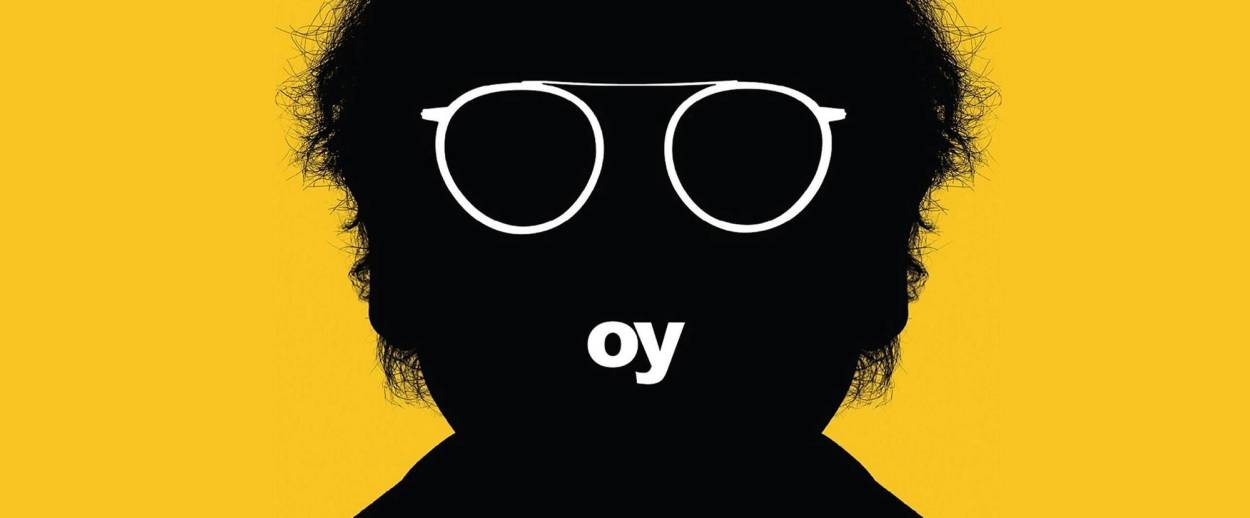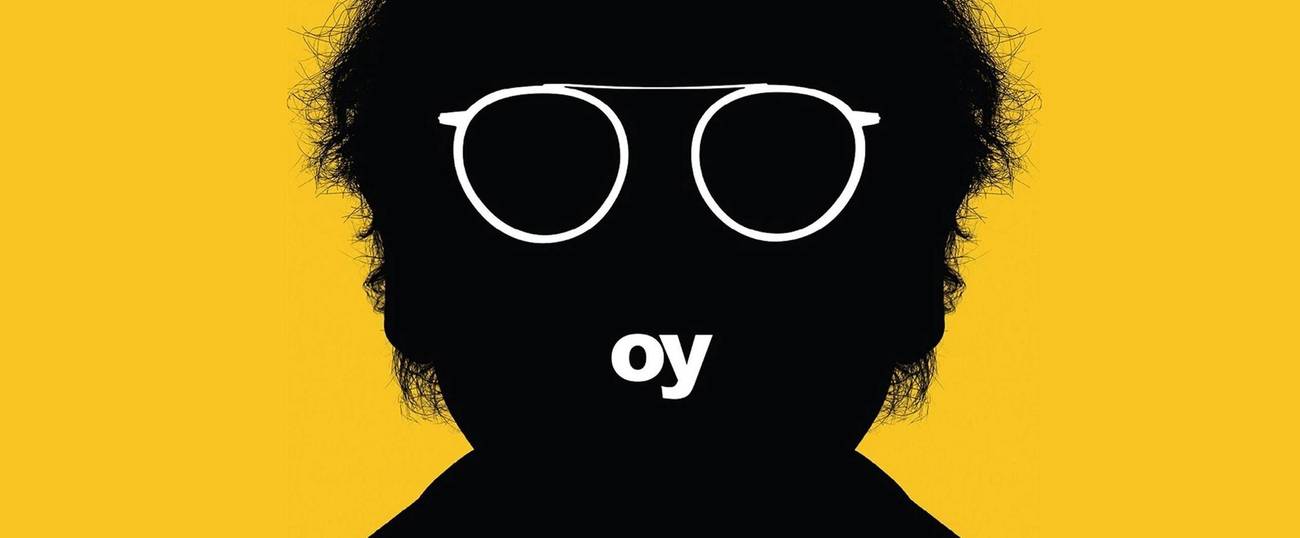All for ‘Oy’ and ‘Oy’ for All
How Yiddish—the language and the sensibility—made its mark on American advertising




He’s back … and from the look of it, so, too, is the Yiddish word “oy” (though without its companionable “vey”). I’m referring here to Larry David, whose curmudgeonly, dyspeptic persona has returned to HBO after an absence of a few years, and to the equally dyspeptic, traditional Ashkenazic expression of woe and rue.
You need not be a fan of Curb Your Enthusiasm to be aware of the comedian’s comeback: A poster of his face bears down on those who ride the New York subway or live online. Much like the silhouette of yesteryear—a prized graphic art form of the 19th century in which bodily features were hinted at rather than fully elaborated upon—its contemporary equivalent consists of an oval sporting a pair of ears, a pair of eyeglasses, and tufts of hair set amid a muddied yellow ground. In lieu of a mouth, two letters come together to form the word “oy.” As much moue as mewl, the Yiddish expression stands alone without even the slightest gesturing at interpretation.
I wonder about that “oy.” Why not draw on a contemporary refrain rather than on something straight out of Grandpa’s—or Great-Grandpa’s—playbook? After all, it’s not as if “oy” is one of David’s signature expressions. I’ve watched the show year after year and don’t recall his slinging it about on a regular basis. (Susie Greene, David’s sharp-tongued nemesis, is another story.) Then again, the comedian’s cranky character is the embodiment, the living personification, of the word. Is that what the show’s promoters are getting at?
Or did they take their cue from Deborah Kass’ sculptural homage, “OY/YO,” which, these days, can be seen at New York’s Jewish Museum? (An earlier version was situated in Brooklyn Bridge Park.) Fashioned out of shiny yellow painted aluminum, one side of the sculpture reads “OY” in really big letters while the other reads “YO.” Everything about the piece, from its scale and color to the way in which it translates sound into visual expression, beckons. Maybe, just maybe, it spoke to Larry David’s creative team as well?
While speculating, it occurred to me that perhaps “oy” had retained its hold on the contemporary imagination and was as popular in its own way as LOL or WTF. Could it be that the age-old “oy” had become “cool”? I put that question to my media-savvy students who, to a person, responded in the affirmative, adding that “oy” is often deployed when texting. Who knew?
What I do know, though, is that deploying Yiddish, and ethnic Jewish humor more broadly, as an advertising gambit has a long history behind it. For starters, the American Yiddish press of the late 19th and early 20th centuries was chockablock with advertisements for novel products that ranged from foodstuffs to furniture. Manufacturers fastened on Yiddish as a way to trumpet the virtues of their newfangled products to Jewish consumers. Sometimes all it took was transliteration—rendering American words in Yiddish characters. When in 1924, for instance, Jell-O sought to cultivate a Jewish market for its wobbly product, it published an illustrated Yiddish recipe booklet in which the words “lemon Jell-O” and “salad” were the same as they were in English, except for the alphabet used to spell them.
At other moments, Yiddish responded to the temper and tenor of the times by giving a contemporary spin to its age-old lexicon. A year before the debut of Jell-O, the Jewish Daily Forward sought to entice its readers to attend a masked ball that it sponsored. An advertisement for the 1923 event, which Chana Pollack, the paper’s redoubtable archivist, kindly shared with me, drew on the age-old phrase “lebn a gutn tog” (literally, “have a good day”) to make the point that those who attended would be sure to enjoy themselves. “An entire city of folks, not thinking about anything except having fun,” would be on hand, read the pitch, before closing with this characteristically choice bit: “You could stay home.”
Later still, as the children of East European immigrants came of age and entered the American workforce, they brought with them the cadences of their parental language, its emotional register of questioning and deflating, its quizzical, ironic sensibility. Surely it’s no coincidence that enduring advertising gems such as “Does she … or doesn’t she?” and “The closer he gets, the better you look” came from the pen of copywriter Shirley Polykoff, the daughter of Hyman and Rose, two Ukrainian, Yiddish-speaking Jewish immigrants who settled in Brooklyn in 1905. Her career as a highly successful, imaginative copywriter was foretold when, early on, she came up with the slogan “Rhinestones, a girl’s next best friend” to promote the wares of a local fashion store.
Polykoff’s gifts, long an inside secret, the stuff of shop talk, became more widely known thanks to “True Colors,” a 1999 New Yorker article by Malcolm Gladwell in which he detailed the cultural process by which “painting,” or coloring, one’s hair moved from a louche practice to a normative one. Miss Clairol, an easy-to use, no muss, no fuss product, which in a mere 20 minutes lightened, shampooed, and conditioned a full head of hair, was the medium; Polykoff’s advertising copy of 1956, “Does she … or doesn’t she?” the message. (Or, as Polykoff’s future mother-in-law wanted to know: Fahrbt zi der huer? Oder fahrbt zi nisht?)
At once breezy and compelling, Polykoff’s catchphrase took the sting (quite literally) as well as the stigma out of changing one’s appearance. “Tangled up in the politics of assimilation and feminism and self-esteem,” coloring one’s hair, Gladwell writes, placed a sense of possibility, of personal transformation, within reach. Little wonder, then, that “Does she … or doesn’t she?” became more than an advertising slogan. It, and comparable copy, “somehow managed to take on meanings well outside their stated intention.”
A few years later, in 1961, Judy Protas, another American Jewish female advertising executive, came up with the equally enduring ad campaign and slogan, “You don’t have to be Jewish to love Levy’s Real Jewish Rye,” to tout the virtues of and expand the audience for a Brooklyn bakery’s alternative to white bread. Featuring a gallery of characters drawn from New York’s polyglot population, it, too, assumed a life of its own, becoming as much an affirmation of inclusion and urban ethnic diversity as a salute to a specific type of bread.
Though becoming a blonde and snacking on a seeded rye tuna sandwich have arguably little in common, they’re bound together by the wistfulness of their respective advertising campaigns, both of which advanced consumers’ hopes for something better and more life-enhancing. At the risk of oversimplifying, or, worse still, of essentializing, might not Yiddish be subtly at work here, behind the scenes? Not as a spoken language, but as a sensibility, a way of looking at the world, or what my colleague Jeffrey Shandler defines as a “post-vernacular” phenomenon. Might not its combination of skepticism, humor, and possibility serve as the perfect formula for the promotion of consumer goods—and of Larry David, too, whose onscreen character makes good on each one of these characteristics?
One final thought: If “oy” is back in circulation (or never left), can “nu” be far behind?
***
Like this article? Sign up for our Daily Digest to get Tablet magazine’s new content in your inbox each morning.
Jenna Weissman Joselit, the Charles E. Smith Professor of Judaic Studies & Professor of History at the George Washington University, is currently at work on a biography of Mordecai M. Kaplan.